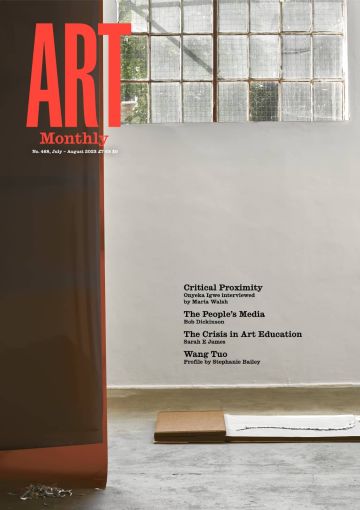Review
Artists in a Time of War
Max L Feldman finds that this historical survey exhibition is nevertheless most focused on current events in Ukraine and Afghanistan

Rahraw Omarzad, New Scenario, 2022-23
Over eight rooms, each dedicated to either one specific war or a cluster of conflicts, ‘Artists in a Time of War’ brings together 140 works by 30 artists responding to a war they have lived through. Obviously there has never been a time when artists were not responding to war, and curators Carolyn Christov-Bakargiev and Marianna Vecellio rightly do not offer a grand theory of war and its causes. Instead, the focus remains on two current wars: Russia’s depraved invasion of Ukraine and the aftermath of the failed ‘war on terror’ in Afghanistan.
The walls of each gallery are painted in a different colour, for example a dark grey covers the room featuring works by Fabio Mauri that reference the local tragedy of the bombing of Turin. Contrastingly, two rooms feature a wan pale yellow that obliquely suggests a link between the Napoleonic invasion of Spain (featuring works by Francisco Goya), the Second World War (Anton Zoran Mušič, Lee Miller, Alberto Burri), the Spanish Civil War (Pablo Picasso, Salvador Dalí) and the Six Day War (Bracha L Ettinger). A room featuring Dinh Q Lê’s installation Light and Belief: Voices and Sketches of Life from the Vietnam War, 2012, is painted orange to remind us of the US Air Force’s use of the cancerous chemical herbicide Agent Orange to flush out Viet Cong soldiers by systematically defoliating the jungle.
The exhibition prompts us to ask how our moral responses to these wars have been shaped by earlier wars. A viewpoint clearly shaped, in part, by classic artworks. Examples such as Goya’s depiction of bloodied Spanish rebels fighting Napoleonic forces in an etching from ‘Disasters of War’, 1810–15, and the howls of the mangled in Picasso’s Guernica, 1937, refracted here in his portrait of Dora Marr in Head of a Woman, 1942, become historical lodestars through which the exhibition’s themes emerge. A further understanding of recent horrors is expressed in Mušič’s fraught ink and pencil drawings and Miller’s photographs of the wretched piles of corpses from Dachau and Buchenwald, and the psychic wounds after the Balkan wars in Anri Sala’s 1999 video Nocturnes.
The exhibition also asks questions about the way individual and state-led sympathies align or diverge. Alberto Burri, for example, was on the ‘wrong side’ of the Second World War and ended up with other Italians in a prisoner of war camp in Texas, the featureless landscape and intense heat we see in his early oil painting from 1945. Lê’s selections, however, are lighter and almost celebratory in tone, capturing Viet Cong soldiers eating, talking, preparing for battle and tramping through the jungle. Yet the viewer’s sympathies are by no means guaranteed; they are equally shaped by those opposing the horrors of the Vietnam War and official anti-communist rhetoric and imagery.
Nikita Kadan’s The Shelter II is a life-size two-storey bomb shelter: an upper space is crammed with books mirroring how Ukrainian civilians have safeguarded their homes from all-too-possible shattered glass and shrapnel. The lower level resembles a tomb with a cast bronze hand reaching out of the black dirt. Kadan is partly based in Bucha, where Russian forces tortured and murdered hundreds of Ukrainian civilians in March 2022. The work reveals how ordinary people living under fire are forced to find refuge from slaughter every day. The installation’s lower level appears at first like a black rectangle, perhaps alluding to the Kyiv-born Kazimir Malevich, painter of Black Square, 1915 – an artist who is now rightly being recoded not as a member of the Soviet ‘Russian’ avant-garde, but part of an autonomous Ukrainian artistic culture. As viewers enter the work, the pure black rectangle looks not just painterly, but flat. Step closer and it becomes clear that this is a space with cavernous depth. The result is emotional vertigo: a bottom step missed in the darkness, a sudden rush of grief, or an unhealable inner wound. It is difficult or perhaps impossible to recapture one’s initial view by moving backwards and looking again. The work partially confirms the exhibition’s central premise: to startle us into reconsidering how we perceive war.
The Afghan artist Rahraw Omarzad’s Every Tiger Needs a Horse, 2022–23, has a similar effect. It comprises six works, in which countless tiny specks of black-and-white paint are splattered in a seemingly arbitrary formation across the canvases. Three of the canvases were subject to two controlled explosions under the supervision of the Italian military. While Kadan’s installation partly shows us how an ethics might be found in art, Omarzad’s works are the closest the exhibition comes to making a general statement about what war looks and feels like. It doesn’t just reflect on the way in which military forces put cold, hard technological rationality to irrational ends – mutilation, death and destruction – but may well show us the sheer terrible quantity of possible effects in war.
For those of us who have been spared the experience and the consequent chaos caused by even the briefest of military bombardment, the exhibition is but a tiny, bitter taste of the unimaginable things seen in war: poor boys mashed into trenches; civilians cowering in the ruins of some once-quiet place; the mangled citizens of the swelling necropolis; all creation battered amid the broken glass.
Max L Feldman is a writer based in London.
‘Artists in a Time of War’, Castello di Rivoli, Turin, 15 March to 19 November 2023
First published in Art Monthly 468: Jul-Aug 2023.










